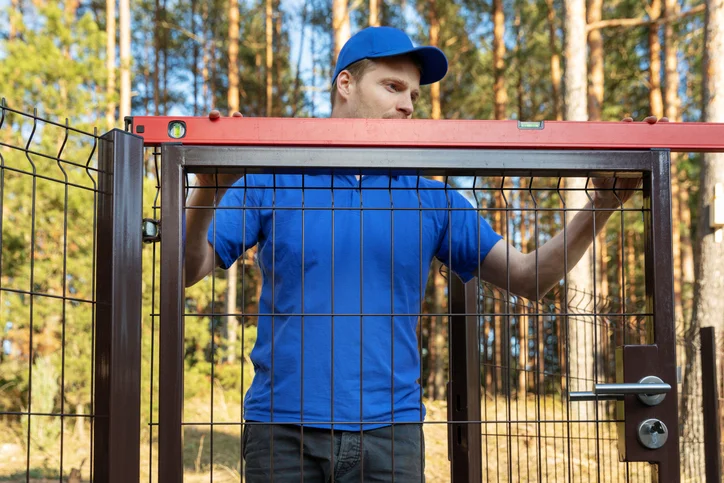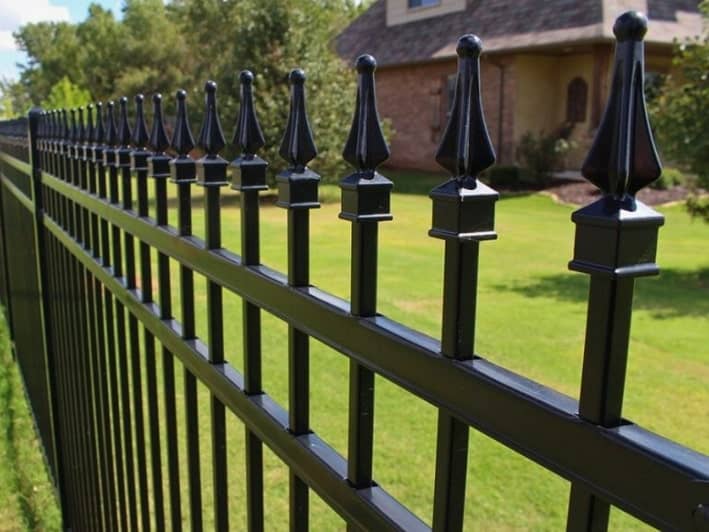Cost-Effective Solutions for Reliable Fence Repair
Cost-Effective Solutions for Reliable Fence Repair
Blog Article
Exactly How to Identify Typical Problems That Require Immediate Fence Repair Work
It is important to spot problems prior to they end up being bigger troubles when it comes to maintaining your fence. Consistently looking for indicators of rotting wood, leaning panels, or corrosion can conserve you time and cash over time. You could not realize exactly how climate and parasites can endanger your fence's integrity. Let's check out the usual indicators that show your fencing needs immediate focus, so you can keep your home safe and looking its ideal.
Indications of Rotting Wood in Wooden Fences
Have you discovered your wood fence looking a bit shabby? It might be time to examine for signs of decaying wood if so. Initially, take a look at the base of the messages and panels for soft places. That's a clear indication of rot if you press on the wood and it really feels squishy or crumbles. Next off, try to find discoloration or dark places on the timber-- these typically signal wetness damages. Pay interest to any kind of peeling paint or surface, as this can subject the wood to further decay. Furthermore, a pungent, mildewy scent can indicate fungal development. Don't fail to remember to check links and joints; if they hang or falling apart, the wood underneath is likely jeopardized. By catching these signs early, you can prevent more extensive damage and keep your fencing standing solid. Regular maintenance is crucial to prolonging the life of your wood fencing.
Leaning or Tilting Fence Panels
If you've observed your fencing panels leaning or tilting, it's essential to recognize what caused it. This problem could show underlying architectural damage that needs your attention. Let's explore the common reasons and the repair alternatives readily available to get your fence back fit.

Root Causes Of Leaning Panels
When you notice your fencing panels leaning or tilting, it's often an indication of underlying concerns that require addressing. One typical cause is insufficient drain; extreme water can deteriorate the dirt around the fence messages, damaging their support. An additional perpetrator could be strong winds or tornados that press against the panels, especially if they're not correctly anchored. Additionally, the all-natural settling of dirt with time can create messages to move, resulting in a tilt. Bugs, like termites, can jeopardize the stability of wooden panels, triggering them to lean. Finally, poor installment practices might result in panels not being firmly set, leaving them at risk to leaning under stress. Address these concerns immediately to maintain your fencing's stability.
Indicators of Architectural Damages
Discovering turning or leaning fencing panels can be startling, as these problems often show structural damage that requires immediate attention. When your fence begins to lean, it may signify that the messages are shifting or that the dirt around them has actually eroded. Pay attention to spaces between blog posts or panels, as these can additionally suggest instability. deck builder. Additionally, look for cracks or splintering in the wood, which can damage the overall structure. It can endanger the stability of the fencing if you notice corrosion or rust on steel elements. Remember, overlooking these indicators can bring about a lot more extreme damages down the line, so it's necessary to examine the situation immediately and act before it gets worse
Repair Service Options Available

Rust and Deterioration in Metal Fences
If you own a metal fencing, you could observe corrosion and rust creeping in over time, especially if it's exposed to dampness. These issues not just impact the appearance of your fence yet can additionally endanger its architectural integrity. To identify rust, search for reddish-brown spots or spots, which show the metal is oxidizing. Corrosion can spread rapidly if left unattended, damaging the fencing and leading to costly repairs.To tackle corrosion and corrosion, you must cleanse the affected areas with a cord brush and use a rust-inhibiting guide. When the primer dries, consider painting the fence with a weather-resistant paint to safeguard it better. Regular upkeep, such as evaluating for indications of corrosion and retouching paint as needed, will certainly assist prolong your fence's life expectancy. Addressing these problems without delay ensures your steel fence continues to be strong and visually appealing for years ahead.
Cracks and Splits in Plastic Fencing

Reasons of Plastic Damage
Plastic fencing is prominent for its longevity, yet it can still suffer from cracks and divides because of various variables. One significant cause is extreme temperature level changes. When vinyl increases in the warmth and agreements in the chilly, it can damage the product in time. In addition, direct exposure to rough sunlight can cause UV degradation, making the plastic breakable. Physical influences, like accidental collisions or heavy branches, can additionally create cracks. Poor installment or making use of low-grade materials can worsen these concerns. Furthermore, age plays a function; older plastic fencing is a lot more susceptible to damages. Routine assessments can help you determine these factors prior to they bring about significant problems. Take proactive procedures to assure your fence continues to be intact and strong.
Repairing Cracks Effectively
Fractures and splits in your plastic secure fencing can be concerning, addressing them promptly can prevent more damage and preserve the fence's look. Examine the dimension of the crack. For small fractures, a vinyl fixing package usually consists of adhesive that can bond the sides, giving a smooth repair. Clean the area thoroughly prior to applying the sticky, guaranteeing it adheres effectively. For larger splits, you may need to use a plastic patch. Cut the patch to dimension, use adhesive around the edges, and press it strongly onto the split. Permit it to cure as per the supplier's directions. Normal upkeep and quick repair work can prolong your fence's lifespan, maintaining it looking excellent for years to come.
Loose or Missing Fencing Posts
Absent or loose fence articles can weaken the stability of your entire fence framework. It's necessary to attend to the issue quickly if you notice any posts leaning or wobbling. Look for any type of indicators of activity, as this can result in more damages in time. You can quickly examine the issue by providing each post a mild shake-- if it feels unstable, it's time to take action.For missing articles, you'll require to change them as soon as possible to preserve your fence's stability. Make sure they're firmly secured in the ground with concrete or gravel for added security when you set up new blog posts. If a message hangs, tighten it by including added support or driving it deeper into the ground.Ignoring these issues can bring about larger troubles, like spaces in your fencing or even total collapse. So, keep an eye on your articles and remain positive regarding repair services!
Damages From Climate and Natural Aspects
Climate and natural environments can create mayhem on your fence, causing different types of damages that call for punctual Read Full Article interest. Hefty rainfall can create wood to rot, making it weak and unsteady. Snow build-up could flex or damage panels, while solid winds can root out fencing messages or cause areas to lean.If you see cracks or splintering in wooden fences, it's an indicator of drying as a result of extreme sunlight exposure. Steel fences can corrosion if protective layers use off, especially in coastal or damp areas.Inspect your fence regularly after tornados or severe weather condition to capture any kind of damages early. Resolving these problems swiftly can conserve you from costly repair services down the line. Do not wait till a tiny trouble turns right into a major one; stay positive and maintain your fencing in leading form to preserve both capability and aesthetic allure.
Pest Invasion and Termite Damage
When you see indicators of insect invasion or termite damages, it's vital to act promptly to avoid more damage. Try to find mud tubes along your fencing or hollow-sounding wood, as these show termites go to job. You may likewise see small openings or frass, which is termite droppings appearing like sawdust. If you detect any one of these signs, it's time to analyze the damage.Don' t delay up until it's too late; parasites can compromise your fencing's stability. Examine the surrounding location for beetles or ants, as they may be adding to the problem. If you think an infestation, take into consideration getting in touch with a pest control specialist to confirm and deal with the issue.Repairing or changing damaged sections of your fencing quickly not only restores its stamina yet additionally stops bugs from spreading better. Remain alert to maintain your residential or commercial property safe and pest-free.
Frequently Asked Inquiries
How Usually Should I Check My Fence for Damage?
You should evaluate your fence a minimum of two times a year, preferably during springtime and autumn. Routine checks aid you detect damage early, conserving you time and money on repair work while keeping your residential property's look and security.
Can I Fix a Fence Myself or Employ a Professional?
You can definitely fix a fencing yourself if you have the right tools and skills. Nevertheless, working with a specialist guarantees high quality work and saves you time, particularly for complicated fixings or considerable damages.
What Tools Are Needed for Fundamental Fence Repair Work?
For fundamental fencing fixings, you'll need devices like a hammer, screwdriver, pliers, a saw, a degree, and measuring tape. deck builder. Relying on the repair work, you could also call for nails, screws, or substitute boards
Just How Much Does Fence Repair Work Typically Cost?
Fencing repair service prices differ commonly, yet you can anticipate to pay in between $200 and $1,500 depending on products, labor, and degree of damage. It's clever to obtain several quotes for the very best deal.
When Is the most effective Time of Year for Fencing Fixes?
The ideal time for fence repairs is during mild climate, usually in springtime or very early fall. You'll avoid extreme temperature levels, making it less complicated to function and ensuring the products set properly for lasting longevity (deck builder). Noticing leaning or turning fence panels can be worrying, as these problems typically show structural damages that needs immediate attention. Loosened or absent fencing blog posts can threaten the security of your whole fencing framework. Snow buildup might flex or break panels, while strong winds can uproot fence articles or create sections to lean.If you see splits or splintering in wood fences, it's an indication of drying out due to extreme sun direct exposure. Metal fencings can rust if safety coatings use off, especially in coastal or humid areas.Inspect your fencing routinely after storms or extreme weather condition to capture any kind of damage early. Fence fixing expenses differ commonly, yet you can anticipate to pay between $200 and $1,500 depending see here on materials, labor, and level of damage
Report this page